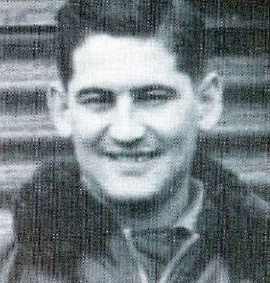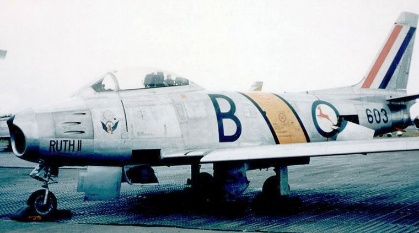MICHAEL COENRAAD BOTHA: MISSING SOUTH AFRICAN AIR FORCE (SAAF) PILOT’S REMAINS FOUND IN KOREA
Compiled by Wolfgang Witschas
Abstract
The remains of a South African Air Force pilot who died in Korea during 1953 has been located and positively been identified by using DNA
Keywords
- “Flying Cheetahs”
- 2 Squadron,
- Gopa island in Seosan
- HMS Ocean
- Korea
- Major Stan Wells,
- Michael Coenraad Botha
- North American Four F-86 F-30 Sabre jet fighters
- Republic of Korea (ROK) Ministry of Defence
- ROK Ministry of National Defence Agency for KIA Recovery and Identification (MAKRI)
- Sabre
- South African Air Force
- U.S. Defence Prisoner of War (POW)/Missing in Action (MIA) Accounting Agency
- Yellow Sea
Introduction
A South African Airforce (SAAF) Pilot, Michael Coenraad Botha, who was part of the SAAF contingent of number 2 Squadron, the “Flying Cheetahs” during the Korean War 1950 to 1953. Botha went missing during a training flight on 28 August 1953 near the Capital of the Republic of Korea (ROK), Seoul a short while after the armistice which came into effect on 27 July 1953.
After more than seven decades (71 years and 8 months) of uncertainty, the family of Second Lieutenant Botha, a who tragically lost his life during the Korean War on 28 August 1953, his remains have been located.

Michael Coenraad Botha of Pretoria. Photo: South African Researcher – Family History & Heritage 
SAAF North American F-86 F-30 Sabre jet fighters: Like the plane that Second Lieutenant MC Botha flew.
Background
Personal Particulars:
Names: Michael Coenraad
Surname: Botha
Date of Birth: 929-08-18
Age: 24
Service No: P1/40815
Rank: Second Lieutenant
Unit: Number 2 Squadron – “Flying Cheetahs”
Regiment: South African Air Force (SAAF)
Date of Death: Friday 28 August 1953
The Incident
It was during a Navy affiliation exercise with the Royal Navy ship HMS Ocean that number 2 squadron the “Flying Cheetahs” suffered its only post war casualty. North American Four F-86 F-30 Sabre jet fighters were engaged in the exercise which took place on the west coast of Korea on 28 August 1953. After pulling out from his mock attack (dummy run) Second Lieutenant “Mike” Botha reported to the team leader, Major Stan Wells, that his aircraft was not responding normally to the controls. When instructed to climb towards the coast. “Mike” reported that the controls were locked on both the alternative and emergency systems. Major Wells advised him to watch his normal system and to head for the coast and bale out if necessary. He ejected at 18 000 ft over land, but he was blown out to the sea and his parachute being seen approximately two miles offshore.
Meanwhile the team leader, Major Wells, had run short of fuel and retuned to base. Taking another Sabre, he led a search team of helicopters an amphibian and two naval units in s fruitless search for Botha. The air – sea rescue operation continued for two days was called off only after thorough questioning of inhabitants of the Gopa Island in Seosan, had failed to yield any useful information. Ironically Botha had returned from an escape and evasion course only the day before he had disappeared into the Yellow Sea. He was never found, despite an intensive search conducted over two days, and is believed to have drowned or been overcome by the mud in the shallow water close to shore. Botha was classified as missing in action (MIA).
Republic of Korea (ROK) Ministry of Defence: Search Project for the remains of a presumed South African pilot
In March 2025 the Republic of Korea (ROK) Ministry of Defence launched the search project following an on-site probe at an island in Seosan, where local residents testified that a U.S. fighter jet crashed i in the area at the end of the Korea war. In 1970 a parachute was found on the beach as well as pieces of aircraft wreckage which they thought must belong to the plane that had crashed in August 1953.
In a follow-up move, the ministry requested the U.S. Defence Prisoner of War (POW)/Missing in Action (MIA) Accounting Agency for relevant data and found evidence lending support to the case.
During March 2025, the ministry also requested cooperation from the South African Embassy in Seoul on potential DNA tests that could take place should the remains be found.
Confirmed: Remains of South African Air Force (SAAF) pilot found 71 years after his death in Korea in 1953 on 03 April 2025
The family of the SAAF pilot, Michael Coenraad Botha, who went missing and presumed dead, on Friday 28 August 1953 in an air crash in Korean, has been found 71 years and 8 months later, by means of an DNA identification of his remains.
After more than seven decades (71 years and 8 months) of uncertainty, the family of Second Lieutenant Michael Coenraad Botha, has been located.
This breakthrough comes as remains believed to be his have been discovered by the Korean Ministry of Defence with the Korean authorities now seeking DNA samples to confirm his identity and bring closure to a long-unsolved mystery.
The South African Researcher – Family History & Heritage Facebook Page posted the information and ask for assistance from the public to locate his family.
The Pretoria weekly community newspaper, Rekord, reported on 03 April 2025 the news that the remains of a presumably SAAF pilot, MC Botha, who went missing in Korea in 1953, had been located. His is family immediately reached out to assist with the DNA samples.
Micheal C Botha said the death of his cousin, Michael Coenraad Botha, has been a family mystery for decades.
Historical Background Information obtained from the Botha Family
“His loss has been a family mystery for decades. His father was Barend Daniel, Uncle Danie, born in 1900; my father was Benjamin, born in 1924.”
“They had a brother named Michael Coenraad, Uncle Mike. Their father was also Michael Coenraad. I was born in 1955 and named after my deceased grandfather and cousin.
“So, three of us carried our father and grandfather’s name. This is an incredible surprise.”
He said they all knew about the story but had a different version of what happened to him.
“I have known the story all my life; he was known as “Klein Mike ” in our Afrikaans family; I inherited the name after I was born in 1955.
“Our grandfather, for who we were named, passed away in 1955.
“The story as we have it is that the Sabres engine flamed out; he could not stretch the glide. He was ejected and went down into the mud – flats off the Korean coast. His parents were heartbroken, and his mother, Auntie Maggie, mourned all her life.”
Botha said his uncle had a sister, Amor, who was a music teacher in Witbank. The family is trying to reach her.
“There is more: Our uncle Spike was a pilot in WW II. Our grandfather, Michael, who fought in the Boer war and was related to Louis Botha and lived in Sunnyside, refused to allow my father to join the SAAF. Then, he lost his grandson in the Korean War.”
According to Anne Lehmkuhl, the founder of the South African Researcher – Family History & Heritage, who spoke to Michael (cousin of the deceased) that it was quite emotional and gave her goose bumps. He is very open to DNA tests and will get other cousins to test, too.
His elderly mother, who is the aunt of the deceased, was with him and still knew the pilot. I hope that the family finally gets closure on this mystery.” Anne Lehmkuhl said the family would be put in contact with the correct people for the DNA tests to be conducted.
Epilogue
The ROK Ministry of National Defence Agency for KIA Recovery and Identification ( MAKRI) is responsible for the search of the remains of members of the members of Allied Forces that formed part of the UN Forces during the Korean War (1950 to 1953)
MAKRI believes that some of the unidentified remains are not American or Korean, but from other sending states such as South Africa, Australia and New Zealand, therefore encouraged sending states to have families of those fallen soldiers who have not been accounted for yet to submit DNA samples which can be used to identify remains.”
According to SAAF Colonel (Retired) Dirk Louw, president of the South African Korean War Veterans Association (SAKWVA), of the 36 South Africans who lost their lives during the war, either Killed in Action (KIA), Missing in Action (MIA) or died in fatal accidants,11 are buried in the United Nations Military Cemetery in Busan, Korea. Of the remains of the 24 others that have not been found, Lieutenant MC Botha, is the first. The remainders’ return is still hoped for at home, said Dirk Louw.
References:
Google:/https://www.citizen.co.za/rekord/
Pretoria Rekord dated 03/04/2025
Journalist: Corné van Zyl
Book:
South Africa’s Flying Cheetahs in Korea, Page 195, Chapter 17: After Armistice. Dermont Moore & Peter Bagshawe, Ashanti Publishers; 1991
Google:/https://www.koreatimes.co.kr/southkorea-begins-war-remains-search-project-for-presumed-south-african-pilot
Google:/https://koreajoongangdaily.joins.com/2020/09/27/national/diplomacy/Heroes-from-afar-South-African-Korea-War/20200927152104132.html
South African Air Force Museum/South African Korean War Veterans Association (SAKWVA)
Korea Armistice is op 27 July 1953.

Hello, I would like to get in touch with Corne van Zyl regarding Mike Botha. I’m doing some research on him and need some assistance
Kim – he is attached to the Rekord Newspaper here in Pretoria.